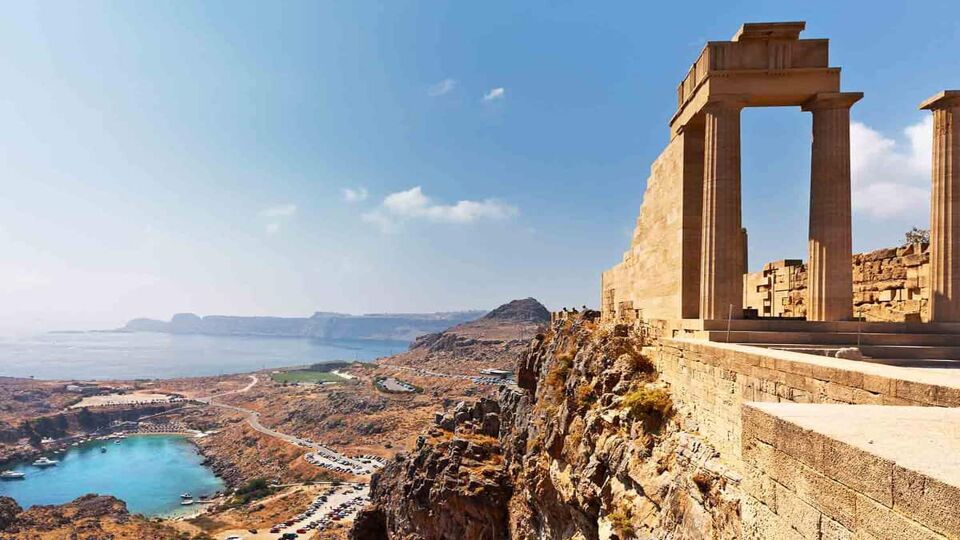Rhodes
Price €27
Min age 0
Rating 4.72 / 5 [544 ratings]
Tour supplied by:
Bucket list destination:
Rhodes, Greek Islands, Greece

Rhodes is equally renowned for its sun-drenched natural beauty – curvaceous swirls of powder sand, endemic flora, and wildlife ranging from butterflies to loggerhead turtles and miniature horses – as well as its lengthy history, attracting in equal measures both beachcombers and history wonks.
Lying on the crossroads between the Mediterranean and the Middle East, many civilizations have left their mark in every aspect of island life: Greeks and Romans, Byzantines, the Crusader Knights of St. John, Ottomans and, post-World War I, Italians, before Rhodes joined Modern Greece in 1947.
The largest island of the Dodecanese, rising just 11 miles off the coast of Turkey, stretches like a leaning lozenge from north to south.
The capital, Rhodes Town, and most hotel infrastructure lie at the northern tip; the forested, mountainous interior is sparsely populated, while the southern coast is more pristine and uncrowded.
Rhodes Town is divided into the medieval Old Town – a UNESCO Heritage site – and Niohori (New Town) which was the focus of the Italian colonial administration and sports some astonishing architecture.
The key hubs of the island are:
A UNESCO World Heritage site and the best walled medieval town in Greece, Rhodes Old Town is pock-marked by monuments built by the Knights of St. John who ruled the island for 200 years after the Crusades.
Visitors enter this time bubble through the moated gates of St Amboise, St Athanasios or St John, ambling along the cobbled Street of Knights full of 15th- and 16th-century buildings, and marvel at the superbly preserved Knights Hospital.
The northern part of Rhodes Town was partly rebuilt by the Italians, during their post-World War I occupation, in a colonial style that merges the sensuality of Orientalism with the flamboyance of late period Mussolini.
As Rhodes Town was supposed to become the capital of a Fascist Mediterranean Empire, it’s awash with grandiose constructions. The Town Hall, The Municipal theatre, the Casino, the New Market , the University and the Post Office are all visually stunning and stylishly unique.
Whitewashed, donkey-ridden and narrow-laned, this Rhodian village could have just been plucked out of the Cyclades and magically transported below the acropolis. Dignified mansions overlook the streets and finely frescoed churches crown the cul-de-sacs, for trading Lindians survived passing invaders and prospered throughout their history.
Although not as spectacular as Lindos, Kameiros was abandoned early and, lying in the windswept north-western coast, was not recolonised, leaving for posterity a well-laid out ancient town with a cistern and a water network, an open square, villas with coloured plastered interiors, and much more.
Rhodes has a distinctive cuisine, with many dishes spiced by cumin such as Lakani (lamb or goat in the oven with yellow split peas) and pitaroudia (fried split-pea flour patties).
Greek cuisine connoisseurs who think they’ve tasted everything, should try the local version of dolmades (stuffed vine leaves), called yiaprakia, made out from the tenderest of leaves and takakia, an ostensible precursor of baklava.
Honey is a Rhodian speciality so much so that there is a bee museum on the island – buy some jars for home.
Also see John’s round-up of the best traditional Greek foods you must try in Greece.
Our selection of the best Viator tours of this destination, plus helpful tickets and transfers
Rhodes
Price €27
Min age 0
Rating 4.72 / 5 [544 ratings]
Tour supplied by:
Rhodes
Price €48
Min age 10
Rating 4.91 / 5 [269 ratings]
Tour supplied by:
Rhodes
Price €321
Min age 0
Rating 4.97 / 5 [207 ratings]
Tour supplied by:
Rhodes
Price €80
Min age 6
Rating 4.94 / 5 [198 ratings]
Tour supplied by:
Rhodes
Price €72
Min age 0
Rating 4.73 / 5 [187 ratings]
Tour supplied by:
Rhodes overflows with tourists in July and August and, unlike other Greek islands, the weather gets extremely humid during those months.
As it is the Greek island with the longest tourist season, you’d be better off in April-May or September to, yes, early November, when the sea is still relatively warm.
Rhodes’s international airport – the fourth busiest in Greece by passenger numbers – is located in the northwest of the island, 14km from Rhodes Town.
It’s served by regular buses to the capital and taxis are readily available, although many resorts will pick you up for free and the rest will arrange transport for a fee.
There are numerous ferries from Rhodes Town to the rest of the Dodecanese, Crete and Piraeus, although the long crossing times (the quickest clocks 12hrs+ to Piraeus) make flights more convenient.
Island buses are punctual and cheap, connecting Rhodes Town to all settlements south. In the shoulder season timetables change weekly as more routes are added or subtracted, so don’t plan too far in advance.
Taxis are pricey and picky as regards the destination. It’s worth renting a car or a scooter to get around unencumbered.
As all roads lead to Rhodes Town, you don�’t have to stay there to discover its history; many of the resorts are bunched up within a short bus ride from the capital.
The north-western shoreline is teeming with shoulder-to-shoulder resorts, but it’s also very windy. The eastern and southern coasts offer better shelter.
Lindos is undoubtedly the most spectacular Instagrammable spot, Prasonissi at the southern tip has the best Robinson Crusoe vibe, whereas loud Faliraki with its permanently drinking and partying 18-30 target demographic is best avoided.
Rhodes Town has the highest concentration of upscale restaurants, both in the Old Town and in Niohori, but there are many good options all over the island.
You can bump into many family stores in the Old Town that produce their own leather goods, decorative plates, plus handmade gold and silver jewellery.